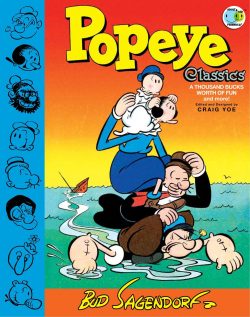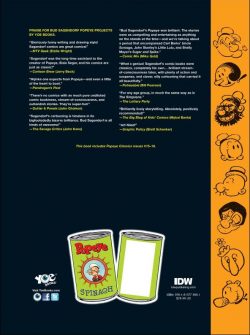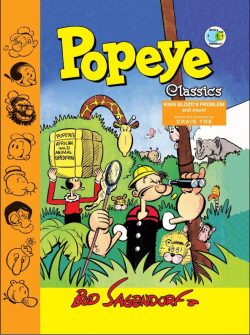
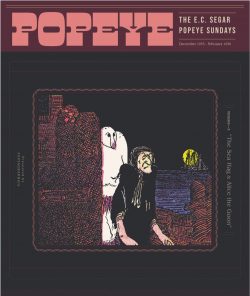
By Elzie Crisler Segar with Bong Redila & various (Fantagraphics Books)
ISBN: 978-1-68396-884-9 (TPB/Digital edition)
Popeye first embarked in the Thimble Theatre comic feature on January 17th 1929. The unassuming newspaper strip had launched on 19th December 1919: one of many cartoon funnies to parody and burlesque the era’s silent movie serials. Its more successful forebears included C.W. Kahles’ Hairbreadth Harry and Ed Wheelan’s Midget Movies/Minute Movies – which Thimble Theatre replaced in William Randolph Hearsts’ papers.
All these strips employed a repertory company of characters playing out generic adventures based on those expressive cinema antics. Thimble Theatre’s cast included Nana and Cole Oyl, their gawky, excessively excitable daughter Olive, diminutive-but-pushy son Castor and Olive’s sappy, would-be beau Horace Hamgravy. The series ticked along nicely for a decade: competent, unassuming and always entertaining, with Castor and Ham Gravy (as he became) tumbling through get-rich-quick schemes, frenzied, fear-free adventures and gag situations until September 10th 1928, when explorer uncle Lubry Kent Oyl gave Castor a spoil from his latest exploration of Africa. It was the most fabulous of all birds – a hand-reared Whiffle Hen – and was the start of something truly groundbreaking…
Whiffle Hens are troublesome, incredibly rare and possessed of fantastic powers, but after months of inspired hokum and slapstick shenanigans, Castor was inclined to keep Bernice – for that was the hen’s name – as a series of increasingly peculiar circumstances brought him into contention with ruthless Mr. Fadewell, world’s greatest gambler and king of the gaming resort dubbed ‘Dice Island’. Bernice clearly affected and inspired writer/artist E.C. Segar, because his strip increasingly became a playground of frantic, compelling action and comedy during this period…
When Castor and Ham discovered everybody wanted the Whiffle Hen because she could bestow infallible good luck, they sailed for Dice Island to win every penny from its lavish casinos. Big sister Olive wanted to come along, but the boys planned to leave her behind once their vessel was ready to sail. It was 16th January 1929…
The next day, in the 108th episode of that extended saga, a bluff, brusquely irascible, ignorant, itinerant and exceeding ugly one-eyed old sailor was hired by the pathetic pair to man the boat they had rented, and the world was introduced to one of the most iconic and memorable characters ever conceived. By sheer surly willpower, Popeye won readers’ hearts and minds: his no-nonsense, rough grumbling simplicity and dubious appeal enchanting the public until, by tale’s end, the walk-on had taken up residency. He would soon make Thimble Theatre his own…
The Sailor Man affably steamed onto the full-colour Sunday Pages forming the meat of this curated collection. This paperback prize is the third of four designed for swanky slipcases, and will present Segar’s entire Sunday canon. Spiffy as that sounds, the wondrous stories are also available in digital editions if you want to think of ecology or mitigate the age and frailty of your spinach-deprived “muskles”…
Son of a handyman, Elzie Crisler Segar was born in Chester, Illinois on 8th December 1894. His early life was filled with solid, earnest blue-collar jobs that typified his generation of cartoonists. Young Segar worked as a decorator/house-painter, played drums to accompany vaudeville acts at the local theatre and when the town got a movie house played for the silent films. This allowed him to absorb staging, timing and narrative tricks from close observation of the screen, and these became his greatest assets as a cartoonist. It was whilst working as a film projectionist, he decided to draw for his living, and tell his own stories. He was 18…
Like so many from that “can-do” era, Segar studied art via mail: in this case W.L. Evans’ cartooning correspondence course out of Cleveland, Ohio – from where Jerry Siegel & Joe Shuster would launch Superman upon the world. Segar gravitated to Chicago and was “discovered” by Richard F. Outcault (The Yellow Kid, Buster Brown), arguably the inventor of newspaper comics. Outcault introduced Segar around at the prestigious Chicago Herald and soon – although still wet behind the ears – Segar’s first strip Charley Chaplin’s Comedy Capers debuted on 12th March 1916. Two years later, Elzie married Myrtle Johnson and moved to Hearst’s Chicago Evening American to create Looping the Loop. Managing Editor William Curley saw a big future for Segar and promptly packed the newlyweds off to the Manhattan headquarters of the mighty King Features Syndicate.
Within a year Segar was producing Thimble Theatre for The New York Journal. In 1924, Segar created a second daily strip. The 5:15 was a surreal domestic comedy featuring weedy commuter/would-be inventor John Sappo and his formidable, indomitable wife Myrtle (!).
A born storyteller, Segar had from the start an advantage even his beloved cinema couldn’t match. His brilliant ear for dialogue and accent shone out from the admittedly average melodrama adventure plots, adding lustre to stories and gags he always felt he hadn’t drawn well enough. After a decade or so – and just as cinema caught up with the introduction of “talkies” – he finally discovered a character whose unique sound and individual vocalisations blended with a fantastic, enthralling nature to create a literal superstar.
Incoherent, plug-ugly and stingingly sarcastic, Popeye shambled on stage midway through ‘Dice Island’ and once his very minor part played out, simply refused to leave. Within a year he was a regular. As circulation skyrocketed, he became the star. In the less than 10 years Segar worked with his iconic sailor-man (from January 1929 until the artist’s untimely death on 13th October 1938), the auteur constructed an incredible metaworld of fabulous lands and lost locales, where unique characters undertook fantastic voyages, spawned or overcame astounding scenarios and experienced big, unforgettable thrills as well as the small human dramas we’re all subject to. They also threw punches at the drop of a hat…
This was a saga both extraordinary and mundane, which could be hilarious or terrifying – frequently at the same time. For every trip to the rip-roaring Wild West or lost kingdom, there was a brawl between squabbling neighbours, spats between friends or disagreements between sweethearts – any and all usually settled with mightily-swung fists and a sarcastic aside.
Popeye was the first Superman of comics and ultimate working-class hero but he was not a comfortable one to idolise. A brute who thought with his fists, lacking respect for authority, he was uneducated, short-tempered and – whenever hot tomatoes batted their eyelashes (or thereabouts) at him – fickle: a worrisome gambling troublemaker who wasn’t welcome in polite society… and wouldn’t want to be. However, the mighty marine marvel may be raw and rough-hewn, but he is fair and practical, with an innate and unshakable sense of what’s right and what’s not: a joker who wants kids to be themselves – but not necessarily “good” – and someone who takes no guff from anybody. Always ready to defend the weak and with absolutely no pretensions or aspirations to rise above his fellows, he was and will always be “the best of us”…
Preceding the vintage views, this tome offers another sublime and compellingly whimsical cartoon deconstruction, demystification and appreciation in ‘Allegro in C Hag Minor’ – An Introduction by Bong Redila’ wherein the multi award winning Filipino American cartoonist (Meläg, Borderline) explores the sparking relationship of the witch and her hairy pal…
There is more than one Popeye. If your first thought when you hear the name is the cheerful, indomitable sailor in full Naval whites always biffing a hulking great beardy-bloke and mainlining tinned spinach, that’s okay. The Fleischer Studios and Famous Films animated features have a vivid brilliance and spontaneous energy of their own (even the later, watered-down anodyne TV versions have some merit) and they are indeed all based on the grizzled, crusty, foul-mouthed, bulletproof, golden-hearted old swab who shambled his way into the fully cast and firmly established newspaper strip Thimble Theatre on January 17th and simple wouldn’t leave. But they are really only the tip of an incredible iceberg of satire, slapstick, virtue, vice and mind-boggling adventure.
This third collection of Segar’s Sunday Colour comics masterpiece spans December 3rd 1933 to February 16th 1936, opening with his magnum opus ‘Plunder Island’ in full, unexpurgated totality, with the epitome of stirring sea-sagas taking up the first six months of that time (ending with the July 15th 1934 instalment). It all kicks off when Popeye’s old shipmate Salty Bill Barnacle invites him to go adventuring in search of fabled Plunder Island, land of stolen treasure, little suspecting that the ghastly villainous Sea Hag who rules it has reared her homely head once more and is very close…
With her new gang of deadly henchmen – including brutal Mister Skom and the monstrous Goon – she kidnaps nerve-wracked Professor Cringly: an aged scholar who knows the lost island’s location. Is Popeye’s latest voyage over before it has begun…?
Gathering a bunch of decidedly dubious amateur Argonauts – including but not exclusively comprising – J. Wellington Wimpy, diner owner Rough-House, “Gobbler” George W. Geezil and private cop G.B. Gritmore, Olive Oyl, Salty Bill and Popeye give chase. It seems hopeless until the Witch of the Seas makes her big mistake and sends her monstrous mute Goon to take hostages. The uncanny creature returns with the indomitable sea salt and inexplicably irresistible Wimpy. The latter’s heretofore unsuspected amatory attractions promptly turn the gruesome heads of both the Hag and her mute minion – who is apparently a rather decent if unprepossessing mother answering to Alice…
In this sinister saga Segar’s second greatest character creation – morally maladjusted master moocher Wimpy – gradually takes over, threating Popeye’s star status with shameful antics and scurrilous schemes. Among so many timeless supporting characters, craven mega moocher Wimpy stands out as the utter antithesis of feisty big-hearted Popeye, but unlike any other nemesis I can name, this black mirror is not an “emeny” of the hero, but his best – maybe only – friend…
The Mr. Micawber-like coward, moocher and conman debuted on 3rd May 1931 as an unnamed referee officiating a bombastic month-long bout against pugilist Tinearo. He struck a chord with Segar who made him a (usually unwelcome) fixture. Eternally ravenous and always soliciting (probably on principle) bribes of any magnitude, we only learned the crook’s name in May 24th’s instalment. The erudite rogue uttered the first of many immortal catchphrases a month later. That was June 21st – but “I would gladly pay you Tuesday for a hamburger today” – like most phrases Everybody Knows, actually started as “Cook me up a hamburger, I’ll pay you Thursday”. It was closely followed by my personal mantra “let’s you and him fight”…
Sunday Pages followed a decidedly domestic but rowdily riotous path, increasing given over to – or more correctly, appropriated – by the insidiously oleaginous grifter: ever hungry, intellectually stimulating, casually charming and usually triumphant in all his mendicant missions. Whilst continuing Popeye’s pugilistic shenanigans, the strips moved away from him hitting quite so much to alternately being outwitted by the unctuous beggar or saving him from the vengeance of furious eatery-owner Rough-House and fellow daily diner Geezil. The soup-slurping cove began as an ethnic Jewish stereotype, but like all Segar’s characters soon developed beyond his (now so very offensive) comedic archetype into a whole person with his own story and equally unique voice. Geezil was the most vocal advocate for murdering the insatiable sponger…
Fair warning: this was an era of casual racial stereotyping completely acceptable and indeed a key component of cartooning and all mass entertainment. Segar sinned far less than most: his style was more character-specific, and his personal delight was playing with accents and how folk interacted. Geezil wasn’t just a Jewish stock figure of fun, but as fully rounded as any of nearly 50 supporting cast members could be within page/panel count constrictions.
Wimpy was incorrigible and unstoppable – he was even a rival suitor for Olive’s unappealing affections whenever food or money (for food) was in play. He grew from Segar’s love and admiration of comedian W.C. Fields. A mercurial force of nature, the unflappable mendicant is the perfect foil for Popeye. Where the sailor is heart and spirit, unquestioning morality and self-sacrifice, indomitable defiance, brute force and no smarts at all, Wimpy is intellect and self-serving greed, freed from ethical restraint and devoid of impulse-control.
Wimpy literally took candy from babies and food from the mouths of starving children, yet somehow Segar made us love him. He is Popeye’s other half: weld them together and you have an heroic ideal… (and yes, those stories are all true: Britain’s Wimpy burger bar chain was built from the remnants of a 1950s international merchandising scheme seeking to put a J Wellington Wimpy-themed restaurant in every town and city).
Rollercoaster adventure, thrills, chills and raucous riotous comedy have never been better blended than in Plunder Island, but when the victorious crew return home, the fun doesn’t stop as we see the bitter aftermath and how our various treasure-seekers dispose of or lose the fabulous wealth they’ve won. Wimpy simply and rapidly eats his way through most of his, whilst Popeye once again gives his cash away, prompting a return to prize fighting against a succession of increasingly scary and barely human opponents. One such man-mountain is Kid Nitro with Wimpy again playing extremely partial referee. When the unscrupulous umpire bets all he has left against Popeye, the Sailor Man pauperises the cheat just by being his valiant self…
For a while, unrelated gag sequences (fights and romantic tiffs) keep the ball rolling every sabbath before mighty “infink” Swee’pea makes his Sunday debut on 28th October 1934 (after being initially introduced in the daily strip: see E.C. Segar’s Popeye volume 3: “Let’s You and Him Fight” ). Adopted by Popeye, he became the focus of many outrageous episodes allowing audiences to comfortably decompress before the next Big Story. These gag exploits see Popeye dally with “High Sassiety” and inadvertently turn effete, spoiled rich child William Bankley into wholesome fun-loving little tough guy Bill whilst honing in on Wimpy’s appetite, ruthless scavenging of pets and livestock and duck hunting antics.
They culminate in appalling excess consumption and his mooching never ends: permanently predating on Rough-House and the distressed cobbler and leading to a shocking sequence of strips where – driven mad by Wimpey’s relentless mooching – the shoemaker kills his despised nemesis with burgers garnished with rat poison…
That aforementioned approaching epic then mines western themes as the cast (plus prodigal brother Castor Oyl) head west to Slither Creek (April 14th to August 25th 1935) as gold prospectors, with Wimpy lost in the desert, undergoing incredible – and well-deserved – hardships as Swee’Pea perpetually proves the benefits of a spinach-&-milk diet. Somehow, the sunny sojourn leaves Wimpy rolling in gold when they return home. As Popeye goes back to battling bulky boxers and sparring with Olive, the temporarily wealthy, eternally empty Wimpy buys his own diner in the ultimate expression of blind optimism and sheer folly. Eventually, the master beggar triumphs over all and gets to eat his fill… and must deal with the consequences of his locust-like consumption…
These tales are as vibrant and compelling now as they’ve ever been, comprising a classic of graphic literature only a handful of creators have ever matched. Segar famously considered himself an inferior draughtsman – most of the world disagreed and still does – but his ability to weave a yarn was unquestioned, and grew to astounding and epic proportions in these strips. Week by week he was creating the syllabary and lexicon of a brand-new artform: inventing narrative tricks and beats that generations of artists and writers would use in their own creations. Despite some astounding successors, no one ever bettered Segar.
Popeye is five years shy of his centenary and deserves his place as a global icon. How many comics characters are still enjoying new adventures 95 years after their first? These volumes are a perfect way to celebrate the genius and mastery of E.C. Segar and his brilliantly flawed superman. These are tales you’ll treasure all of your life and superb books you must not miss.
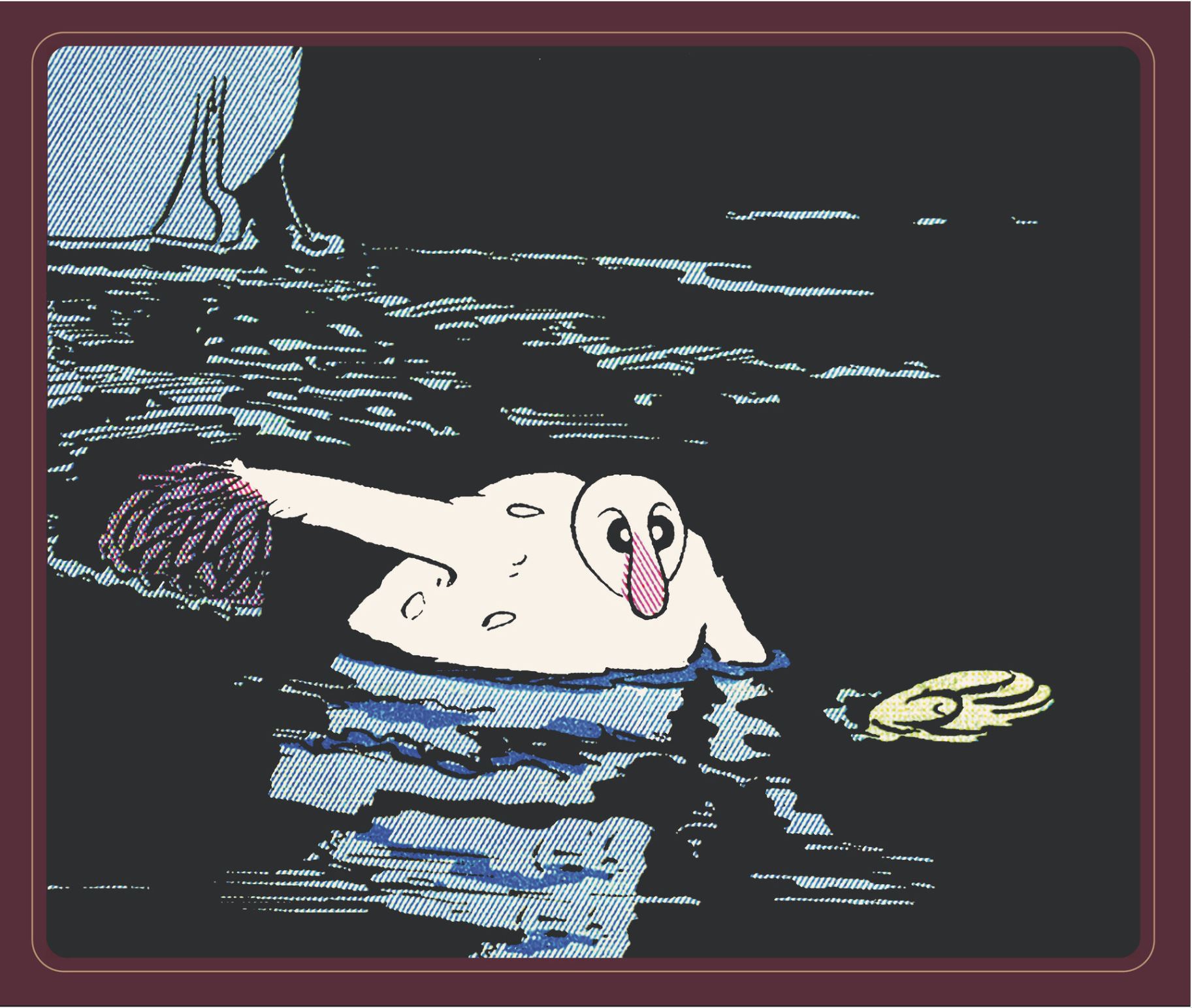
Popeye volume 3: The Sea Hag & Alice the Goon is copyright © 2023 King Features Syndicate, Inc./™Hearst Holdings, Inc. This edition © 2023 Fantagraphics Books Inc. Segar comic strips provided by Bill Blackbeard and his San Francisco Academy of Comic Art. “Allegro in C Hag Minor” © 2023 Bong Redila. All rights reserved.

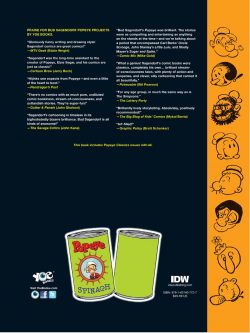
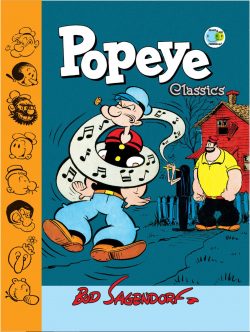

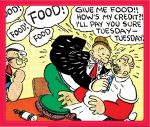

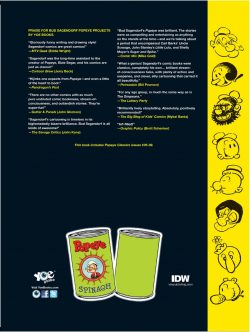
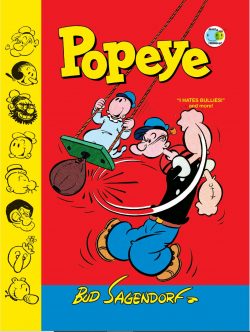

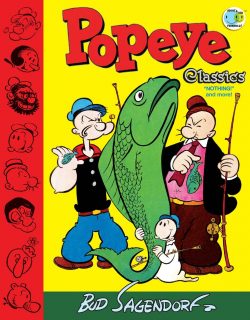
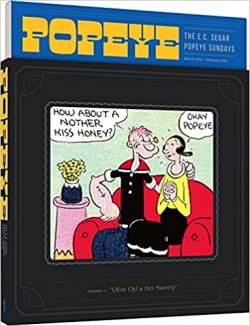
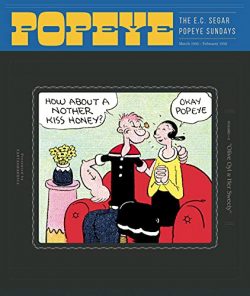

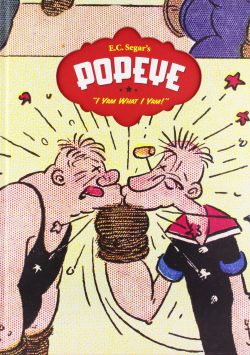
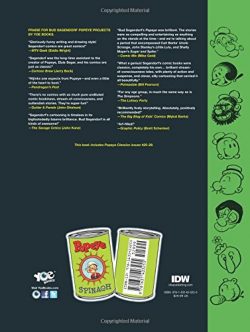
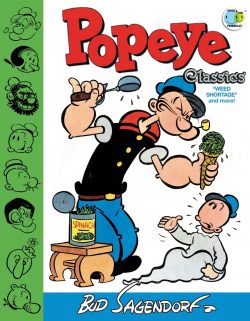
 .
. 